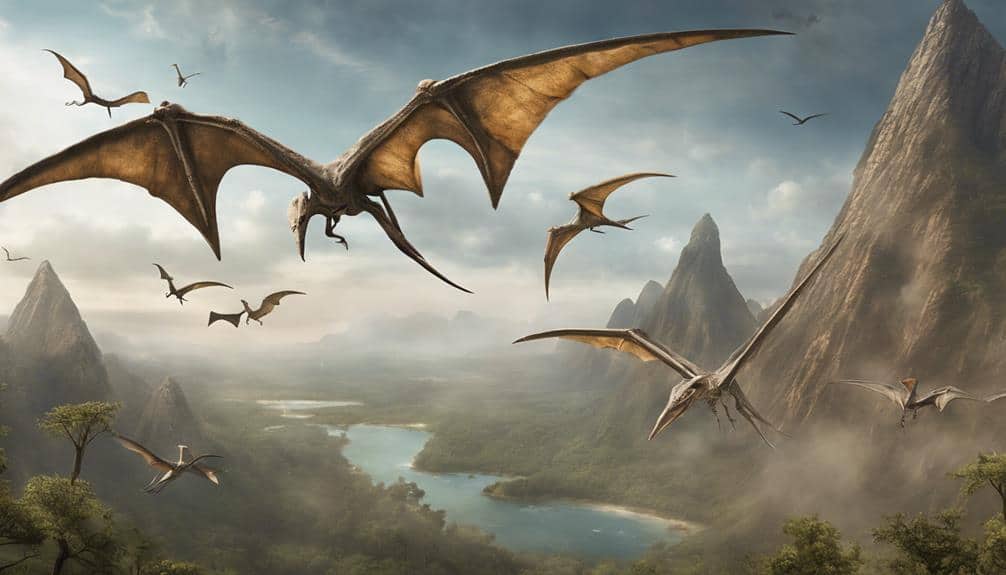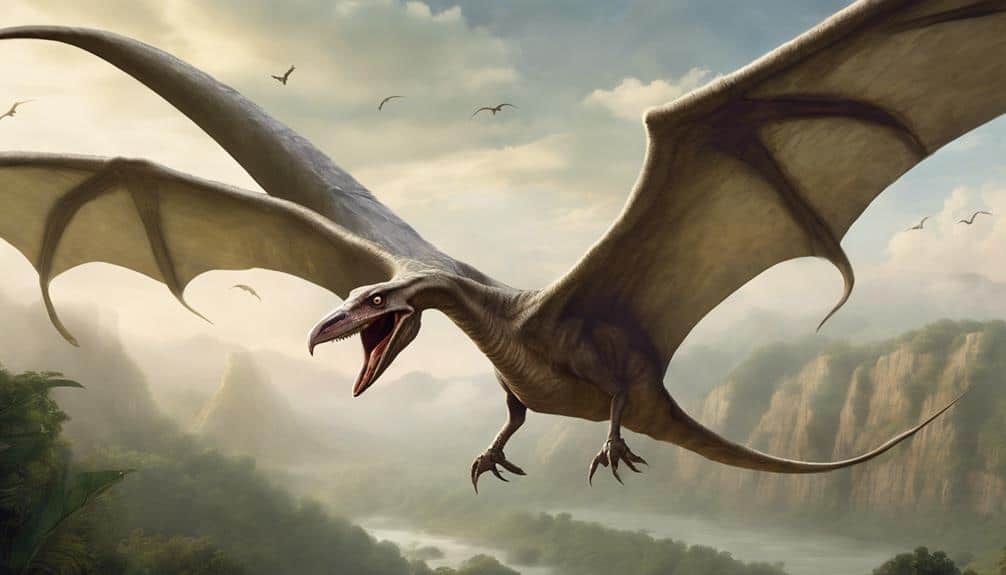Is a Pterodactyl a Pterosaur? Picture this: you’re flipping through an ancient illustrated atlas of the skies of the Mesozoic era, filled with creatures that ruled the air long before birds. Among these majestic flyers, the names Pterodactyl and Pterosaur frequently catch your eye, sparking curiosity about these prehistoric aviators and their lineage. This scenario sets the stage for an exploration into the fascinating world of these creatures, uncovering their secrets and setting straight common misconceptions.

Is a Pterodactyl a Pterosaur?
Yes, a Pterodactyl is indeed a type of Pterosaur. This clarification is essential for understanding the taxonomy of these ancient creatures. The term ‘Pterodactyl’ specifically refers to members of the genus Pterodactylus, which are part of the larger group of Pterosaurs, encompassing a diverse array of flying reptiles that lived during the Mesozoic era.
Pterosaurs, the extinct winged reptiles, thrived from the Late Triassic Period, marking their significance in prehistoric aviation as the first animals to achieve powered flight after insects. Their unique anatomy, featuring hollow bones lightweight enough for flight, set them apart in the evolutionary chain.
Fossils discovered in Bavaria, particularly of the Pterodactylus antiquus species, provide a window into their era, showcasing their diverse physical features. These creatures were not classified as dinosaurs, despite common misconceptions, displaying a wide range of sizes and adaptations. The pterosaurs varied in size, from small species that could perch on your finger to the largest flying reptile, which dominated the prehistoric skies.
The evolution of pterosaurs is a tale of diversity and adaptability, with pterosaurs living from the late Triassic and evolving into dozens of species. Their skeletons, though fragile, survive as fossils, revealing their warm-blooded nature and efficient respiratory systems, traits that hint at a high metabolism and an active lifestyle. Pterosaurs first animals after insects to take to the skies, they revolutionized prehistoric ecosystems with their ability to fly.
Their story, from the first powered flight to the emergence of pterosaur species showcasing a myriad of physical features, underscores the dynamic evolutionary journey of these fascinating creatures. Through their existence, pterosaurs illustrate the complexity and diversity of life on Earth, leaving an indelible mark on the history of vertebrate flight.
Table of Contents
Key Takeaways
- Pterodactyls are a subset of pterosaurs, not a separate group.
- Pterosaurs include a wide range of species, including what are colloquially called pterodactyls.
- The term “pterodactyl” is often used in popular media to refer to all pterosaurs.
- Both pterodactyls and other pterosaurs exhibited features like wing membranes and skull crests.
Now, as we continue on this journey, we’ll uncover the unique characteristics that not only set Pterodactyls apart from other Pterosaurs but also their significant contributions to our understanding of life millions of years ago. Imagine the skies filled with these fascinating creatures, each with its own story to tell. From their anatomy to their role in ancient ecosystems, there’s so much more to discover about these rulers of the Mesozoic skies. So, stay with me as we explore the intriguing world of Pterodactyls and Pterosaurs, and who knows what other secrets we might uncover?
Pterosaur Primer: Flying Reptiles, Prehistoric Prowess, and Skeletal Composition
Pterosaurs, the earliest vertebrates known to have achieved powered flight, exhibit a remarkable diversity in skeletal composition, particularly in their wing structures, which evolved to support various flight mechanisms and ecological niches.
Their diets were equally varied, ranging from piscivory to carnivory, reflecting adaptations to a wide range of prehistoric ecosystems.
The analysis of their skeletal remains, including unique features such as hollow, air-filled bones and specialized limb constructions, offers profound insights into their flight capabilities, predatory strategies, and overall role within the Mesozoic era’s complex food webs.
Wing Structure Evolution
The evolution of a unique wing structure allowed pterosaurs to excel in powered flight. This wing structure consists of a thin membrane. The thin membrane connects pterosaurs‘ bodies to their elongated fourth fingers. pterosaurs‘ distinction within the reptilian lineage becomes evident through this adaptation. Their preeminence in prehistoric skies is due to their mastery of flight.
A specialized membrane characterizes the wing structure. This membrane includes skin and muscles. These skin and muscles improve flight efficiency. Elongated bones support the wing structure. These bones enhance pterosaurs‘ aerodynamic capabilities. Diverse adaptations appear across pterosaur species. These adaptations tailor flight to ecological niches.
The wing structure contributes to pterosaurs‘ status. Their status as formidable aerial predators is notable. The wing structure represents evolutionary innovation. This innovation is characteristic of prehistoric flying reptiles. The study of pterosaur wing structure evolution offers insights. These insights pertain to their flying mechanics and adaptation to aerial life.
Diet and Ecology
Investigating the diets of pterosaurs reveals their ecological positions and survival mechanisms within ancient environments. The pterosaurs‘ ability to adapt is highlighted by their varied diets, which were crucial for their ecological prominence. These dietary adaptations shed light on the evolutionary capabilities that enabled pterosaurs to flourish.
- Pteranodon feeds on fish.
- Pteranodon possesses throat pouches for its diet.
- The diet of Quetzalcoatlus remains unknown.
- The size of Quetzalcoatlus leads to speculations about its diet.
- Toothed pterosaurs consume small animals and insects.
- Toothed pterosaurs display varied tooth shapes for their diet.
- Toothless pterosaurs have specific dietary preferences.
- The adaptations of Toothless pterosaurs are currently under study.
- Generalist pterosaurs engage in varied feeding.
- Generalist pterosaurs employ flexible feeding strategies.
This structure demonstrates the relationship between diet, adaptations, and the ecological roles of pterosaurs, underlining their significance in unraveling prehistoric ecosystems.
Pterodactyl Profile: Membrane Wings, Keen Senses, and Cretaceous Era Adaptations

The anatomical structure of pterodactyls, particularly their wing membrane, played a pivotal role in their adeptness for powered flight. This enabled them to navigate the diverse ecosystems of the Cretaceous Period.
Their survival and evolutionary success during this era can be attributed to their keen sensory abilities. These abilities facilitated efficient hunting and foraging behaviors.
These adaptations underscore the pterodactyls’ significant evolutionary responses to the challenges of their time. They highlight their importance in the study of prehistoric life.
Membrane Wing Anatomy
Within the realm of pterosaur anatomy, the membrane wing structure of pterodactyls emerges as a crucial feature. This structure enabled pterodactyls to achieve efficient flight. Furthermore, the membrane wing provided exceptional control during flight.
The membrane itself was a thin structure, extending from the pterosaur’s body to its elongated fourth finger. This extension allowed for efficient flight. The wing finger of the pterosaur was elongated, playing a key role in supporting the wing’s span. This elongation provided structural support.
The ability to fly efficiently and maneuverably was a significant adaptation for pterosaurs. This flight capability allowed pterosaurs to adapt to varied environments. The evolution of aerial locomotion in pterosaurs underscores their evolutionary success.
The Cretaceous Period serves as the backdrop for showcasing the environmental adaptation of these creatures.
Cretaceous Period Survival
- Pterodactyls exhibited adaptability as a trait during the Cretaceous Period.
- Membrane wings provided Pterodactyls exceptional flight capabilities.
- Pterodactyls used keen sensory abilities for effective hunting.
- Dietary adaptations enabled Pterodactyls to exploit diverse food sources.
- Pterodactyls adapted physiologically to diverse climatic conditions in the Cretaceous landscape.
- Evolutionary innovations optimized pterodactyls’ skeletal and muscular systems for flight.
- These adaptations contributed to the evolutionary success of Pterodactyls during the Cretaceous Period.
Evolutionary Journey: Pterosaur Adaptation, Species Diversification, and Mass Extinction
The evolutionary journey of pterosaurs, encompassing adaptation strategies and species diversification, highlights their complex role within ancient ecosystems prior to their mass extinction at the close of the Cretaceous period.
These creatures exhibited remarkable adaptability, evolving over 150 known species that varied notably in size, diet, and physical attributes, demonstrating a broad spectrum of evolutionary responses to environmental pressures.
However, the catalysts for their extinction, occurring approximately 66 million years ago, remain a critical area of paleontological research, offering insights into the vulnerabilities and resilience of ancient airborne vertebrates.
Adaptation Strategies
Pterosaurs exhibited a remarkable array of adaptation strategies, including the evolution of lightweight, hollow bones and hooked claws, which facilitated their mastery of the skies and prowess in hunting across diverse ecological niches. Their evolutionary journey underscores a sophisticated response to the demands of prehistoric life, demonstrating an intricate interplay between biological form and function.
Pterosaurs evolved lightweight, hollow bones, enhancing their flight capabilities. Pterosaurs developed hooked claws, improving their hunting efficiency. Pterosaurs adopted diverse feeding behaviors, accessing various ecological niches. Pterosaurs underwent species diversification, increasing their resilience to environmental changes.
This encapsulation reveals how each strategy contributed to their dominance in prehistoric skies and their ability to exploit a wide range of ecological niches.
Extinction Catalysts
- Climate change caused drastic environmental shifts.
- Emerging avian species competed with pterosaurs for resources.
- Changes in food availability impacted pterosaur dietary specialists.
- Volcanic activity led to atmospheric alterations.
- The asteroid impact at the end of the Cretaceous disrupted ecosystems.
These sentences highlight the complex reasons behind the extinction of pterosaurs, emphasizing the significant impact of environmental and biological factors.
Frequently Asked Questions
Are Pterosaurs and Pterodactyl the Same?
Pterosaurs and pterodactyls are not synonymous; the former encompasses a vast sky of species, while the latter represents a single genus within that expanse. This distinction is essential for accurate scientific classification and study.
What’s the Difference Between a Pterodactyl and a Pteranodon?
The primary difference between a pterodactyl and a pteranodon lies in their physical characteristics; pterodactyls have shorter, robust skulls, while pteranodons feature longer wingspans and distinctive head crests, reflecting their distinct evolutionary paths and ecological niches.
Were All Flying Dinosaurs Pterosaurs?
Not all flying dinosaurs were pterosaurs; this group was distinct and primarily comprised various species, including the specific subgroup known as pterodactyloids. Pterosaurs showcased remarkable diversity, from small insectivores to giants with extensive wingspans.
Is a Quetzalcoatlus a Pterodactyl?
Quetzalcoatlus is not classified as a pterodactyl but rather belongs to the broader group of pterosaurs, specifically within the pterodactyloid subgroup. It lived during the Late Cretaceous period and had a massive wingspan.
